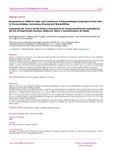Assessment of Flatfoot Index and Prevalence of Musculoskeletal Disorders of the Foot in Young Athletes: Swimming, Rowing and Weightlifting

View/
Use this link to cite
http://hdl.handle.net/2183/30224
Except where otherwise noted, this item's license is described as Atribución-NoComercial-CompartirIgual 4.0 Internacional (CC BY-NC-SA 4.0)
Collections
Metadata
Show full item recordTitle
Assessment of Flatfoot Index and Prevalence of Musculoskeletal Disorders of the Foot in Young Athletes: Swimming, Rowing and WeightliftingAlternative Title(s)
Evaluación del índice de pie plano y prevalencia de trastornos músculo-esqueléticos del pie en deportistas jóvenes: natación, remo y levantamiento de pesasAuthor(s)
Date
2020-12-26Citation
Miguel Andrés, I., Pons Portugal, M., Mayagoitia Vázquez, J. J., Carrum Siller, E. G., & Pérez Rodríguez, M. E. (2020). Assessment of flatfoot index and prevalence of musculoskeletal disorders of the foot in young athletes: swimming, rowing and weightlifting. European Journal of Podiatry / Revista Europea de Podología, 6(2), 58-63. https://doi.org/10.17979/ejpod.2020.6.2.6464
Abstract
[Abstract] Objectives: The objective of this work was to analyze the morphology of the soles of the feet in young athletes to find the prevalence of these pathologies through the Chippaux-Smirak index. Material and Methods: Seventy-five athletes between nine and twenty years old participated in the study (56% female and 44% male), the average mass was 62.92 ± 13.46kg and the average height was 1.67 ± 0.11m. The sports considered in the study were weightlifting, swimming, and rowing. Results: The results clearly show that flatfeet in adolescents and young adults is a condition with a low prevalence level, 10.7% and 12% for the right and left foot, respectively. One of the most outstanding results found in the study is the high prevalence of cavus foot, where women are the most affected by this pathology. Furthermore, swimming presented the highest prevalence of cavus foot, 42.1% and 52.6% for the right and left foot, respectively. Conclusion: In conclusion, the understanding of the morphology of the soles of the feet can help to determine the foot type in these three different sports, and therefore, it can be implemented physiotherapeutic treatments or orthotics devices for overcome the musculoskeletal disorders and prevent future injures. [Resumen] Objetivos: El objetivo de este trabajo fue analizar la morfología de las plantas de los pies en jóvenes deportistas para encontrar la prevalencia de estas patologías a través del índice de Chippaux-Smirak. Material y Métodos: Setenta y cinco atletas entre nueve y veinte años de edad participaron en el estudio (56% mujeres y 44% hombres), la masa promedio fue de 62.92 ± 13.46kg y la altura promedio fue de 1.67 ± 0.11m. Los deportes considerados en el estudio fueron levantamiento de pesas, natación y remo. Resultados: Los resultados muestran claramente que los pies planos en adolescentes y adultos jóvenes son una condición con un nivel de prevalencia bajo, 10.7% y 12% para el pie derecho e izquierdo, respectivamente. Uno de los resultados más sobresalientes encontrados en el estudio es la alta prevalencia de pie cavo, donde las mujeres son las más afectadas por esta alteración. Además, natación presentó mayor prevalencia de pie cavo, 42.1% y 52.6% para el pie derecho e izquierdo, respectivamente. Conclusiones: La comprensión de la morfología de las plantas de los pies puede ayudar a determinar el tipo de pie en estos tres deportes diferentes y, por lo tanto, se pueden implementar tratamientos fisioterapéuticos o dispositivos ortopédicos para superar los trastornos músculo-esqueléticos y prevenir futuras lesiones.
Keywords
Flatfoot
Cavus foot
Chippaux-Smirak Index
Foot
Sport
Pie plano
Pie cavo
Índice de Chippaux-Smirak
Pie
Deporte
Cavus foot
Chippaux-Smirak Index
Foot
Sport
Pie plano
Pie cavo
Índice de Chippaux-Smirak
Pie
Deporte
Editor version
Rights
Atribución-NoComercial-CompartirIgual 4.0 Internacional (CC BY-NC-SA 4.0)
ISSN
2445-1835






